Photographing the Solar Eclipse and the International Space Station
How I Photographed the Sun, the Moon and Six Astronauts in Space
The Great American Eclipse: My Story
Warning: this post is kinda long, so feel free to skim or just look at the pictures. There won't be a quiz at the end, but if you like anything you see, I wouldn't be upset if you upvote, and if you're really feeling crazy you can resteem it too. Y'know, only if you want to.
Buildup to the 2017 Total Eclipse
A few things happened in my life in 2017 - most notably my Canadian road trip, where I spent three months driving across the country - but before I set off on that epic adventure I was in Wyoming on August 21st for the American Total Solar Eclipse.
I knew about the eclipse well over a year beforehand and was planning to photograph it, in a hazy, futuristic, "oh, that's a long time from now, but I'll definitely do it" sort of way. Then life pushed it out of my mind and when spring rolled in I wasn't sure I would have the time, but in June a video from Youtube channel Smarter Every Day that described all the cool things one could expect to see during totality (shadow snakes???) got me excited again, and when a work trip brought me to Louisville in August, I knew there was no way I could skip the eclipse. I started making plans, and that's when I stumbled upon an idea.
The International Space Station
If you haven't heard about it, there's this man-built thing in the sky called the ISS, where astronauts work for weeks, months, or in some cases more than a year at a time. It's an amazing feat of engineering and international cooperation and sometimes you can see it as a bright star gliding through the night sky. A few months before the Big Day I had the idea to check and see if the International Space Station would be transiting the Sun during the eclipse anywhere along the band of totality (there's an app for this). It was, but only in one place in the USA could you see both the ISS transit and totality - not at the same time, but in the same place. The gears started to turn. I had been anxious to find a unique way of photographing the American astronomical event of the decade and here it was...there was no way I was going to miss totality, but now I wanted to photograph the ISS transit too. The place where the band of totality intersected the path of the ISS transit was just west of tiny Crowheart, Wyoming. I put a pin on the map, but there was a lot to do first if I was doing to turn the concept into reality.
What is a solar transit, anyway?
It's when an object comes between the sun and an observer - the intruder could be a planet like Venus, or the moon, or something smaller...like the football-field-sized International Space Station. Its path across the sun from the perspective of the viewer is called a transit. The ISS moves so fast (over 17,000 mph) that depending on the angle of the sun its transit duration could be less than a second. Blink and you literally miss it.
When the ISS passes in front of the sun we see its silhouette starkly outlined against the super-white-hot light of the solar surface. Astrophotographers, notably Thierry Legault (http://www.astrophoto.fr) have been photographing this stellar coincidence for years. Its even possible to photograph the ISS during a lunar transit, but a transit during an eclipse is a rarer bird to catch, and to photograph it within the band of totality rarer still, even if that latter distinction doesn't affect the photo itself.
Disclaimer
Let me explain that last point: if the ISS transit occurred during totality you would never see it, because the station would be in total darkness and invisible. My transit happened during the first stages of the eclipse, so you could say that both the moon and the ISS were "transiting" the sun at the same time, an image that could have been (and was) captured in a few places in the USA outside of the path of totality.
So what? I was in the one place on Earth where I could photograph totality and then sit back and enjoy the spectacular Total Eclipse without moving myself or my telescope, and for me that was really cool and worth all the effort (I wasn't the only one - more on that later).
Gettin' an edumication
Imaging this eclipse was the most technically challenging thing I've ever attempted. Nothing I've done (so far) in photography has compared to it.
I decided that if photographing the eclipse was worth doing, it was worth doing well. I was going to take it seriously and create the best possible images that my time and money could afford, because while it may not be a once-in-a-lifetime opportunity, total eclipses don't come knocking on the door of one's own continent every day. Achieving my self-appointed goals required specialized gear and a crash course in both astrophotography and eclipse photography.
I won't get into the details now (trust me, there are too many details), but I ended up spending more than two straight weeks of research - days where I did nothing but research. I got deep into it. During those weeks I went from complete novice to what might be considered an intermediate-level expertise in the narrow range of skills necessary to pull off the specific images I had in mind. I figured out what I needed to know and ignored everything else. In short, I did the exact opposite of what every article strongly recommended: if you've never seen an eclipse before, don't spend your time photographing it - you will fail and you won't enjoy it!
I know the advice was given with good intent, but I'm glad I didn't listen.
Astrophotography is a rabbit hole, or maybe a black hole. It sucks you in. There is SO MUCH to learn. Soooooo much. And the more you learn, the more you realize that you really don't know anything yet. One line of inquiry leads to another. It's endless. Those weeks I spent on the Cloudynights forum and on other websites were fascinating and I learned so much, but my time was limited so I had to focus on the task at hand. I learned what kind of telescope I would need, and more importantly which equatorial mount to buy. I learned how to connect a camera and then how to get everything working together smoothly. Then there were the small things, just as critical: solar filters, adapters, batteries, and on, and on. With tremendous help from my friend, Photo Decathlon teammate and eclipse collaborator @brandongarrett, we researched the camera settings that would be required during totality and how to switch modes quickly (there are numerous mini-events that happen in the few seconds where totality begins and ends, and they require radically different camera settings, so a lot has to happen very quickly and it has to be flawless).
Every step, every move had to be analyzed, practiced and written down with a precision that a space shuttle pilot might not laugh at.
Most of my self-education was geared towards photographing totality. The ISS was in the back of my mind during the research phase, but I wasn't committed to the idea (hard to put much hope into a plan that could be destroyed by nothing more than a poorly-timed cloud in Crowheart). Thankfully the transit would be relatively simple to capture once the equipment was set up properly - all I had to do was take a video at the right time (I'll explain that later).
Weather thou goest
Once everything under my control had been prepared, weather became the primary concern. A poorly placed storm could mean I'd wasted many weeks and more dollars than I want to talk about, so though I was aiming for a pinpoint in Wyoming, I was prepared to end up anywhere on the path of totality between Oregon's Pacific coast and South Carolina's Atlantic shore, as long as I could be guaranteed clear skies. I looked at the weather as I drove west from Louisville and determined that Wyoming would, indeed, be a safe bet. Even if plan A (the ISS transit) didn't work out, I could find clear skies closer to Casper and wouldn't miss totality.
The journey was pleasant, if rushed, and I saw new parts of the country. I witnessed a ridiculous lightning storm in Missouri - I don't know if folks from the midwest are used to this kind of thing, but I thought it was the prelude to Armageddon.
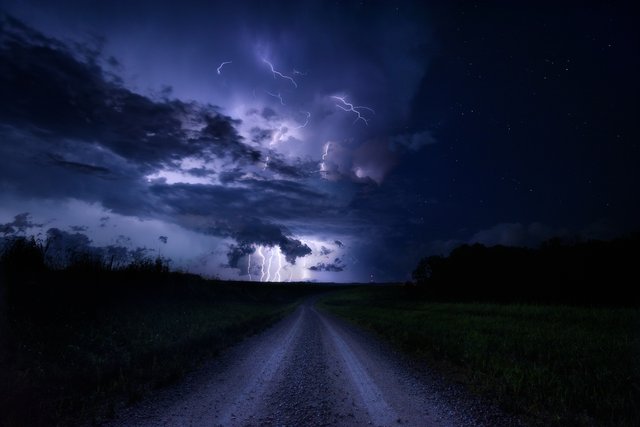
Timelapse of lightning strikes - they were going off as fast as any strobe light.
Crowheart, Wyoming
Since the "path of transit" of the ISS was somewhat south-north and the "path of totality" more west-east, their paths intersected at one specific point on the map - a narrow band just over a mile wide where you could see both things from one place. If I was on the edge of the transit band, I would see the ISS barely touch the corner of the sun; in the interest of observing a longer transit I wanted to be closer to the center of the path drawn on the map. This narrow band passed over the main road, Hwy 26 between Riverton and Dubois. North and South of the road was mostly Wind River Reservation land, which I didn't have permission to access, so the accessible sweet spot was REAAAALY small. I was prepared for the worst case scenario - setting up on the side of the road - but miraculously a rancher had opened up a large area of open land for people to camp on for a reasonable fee. Thank you, capitalism! His land happened to be in exactly the right spot. I pulled in on August 20th, set up camp and talked to several other eclipse chasers that night: a memorable moment when people with common interests converged in the middle of nowhere to witness a solar spectacle (but they hadn't known about the ISS transit until I told them).
The Setup
I set the equatorial mount up at night (it's easier when you can see Polaris).
Morning dawned, bright and...CLOUDY!?? Nooooo! There were clouds in the sky! Not thick, ominous ones, but they looked threatening to me - any kind of cloud cover was no bueno. I waited. One of my new friends from the campground decided to head off to a lake nearby (he wasn't chasing the ISS). More waiting. The forecast was promising, but can you trust the forecast? I was prepared to pick up everything and hit the road...but then the clouds dissipated from the heat of the sun. Clear skies after all!
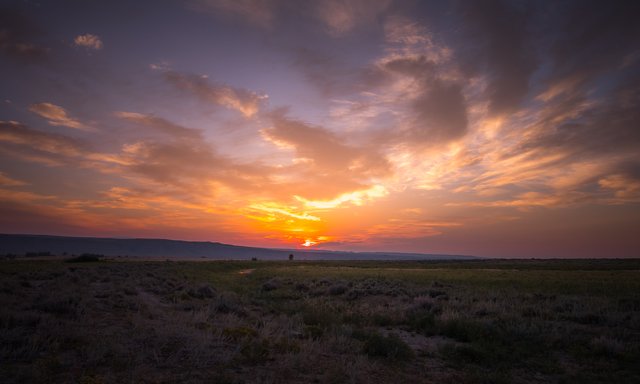
A beautiful but scary sunrise on the 21st
I got everything ready. This took a few hours. Between owning, borrowing and renting I had a lot of equipment:
For primary imaging of totality and the ISS
- Nikon D500
- Explore Scientific 80MM F/6 Triplet Refractor
- iOptron CEM25P Motorized Equatorial GoTo Mount
For telephoto timelapse of the entire eclipse and for video of totality
- Nikon D750 with 70-300mm and Pentax K-5 with 55-300mm, both mounted on:
- Sky-Watcher Star Adventurer Motorized Mount
For wide angle landscape photography:
- Nikon D800 + 14mm wide angle lens
For video:
Pentax K-5, taking video of me during totality (animated GIF below).
GoPro Hero 5 Black, on a flash stand on top of my car, for wide angle video of totality
In case you're wondering, the motorized mounts are used to track the sun across the sky. They do it with smooth, constant, imperceptible motion, and if set up properly can track without adjustment for more than an hour. This means I don't have to constantly readjust the cameras to keep the sun centered.
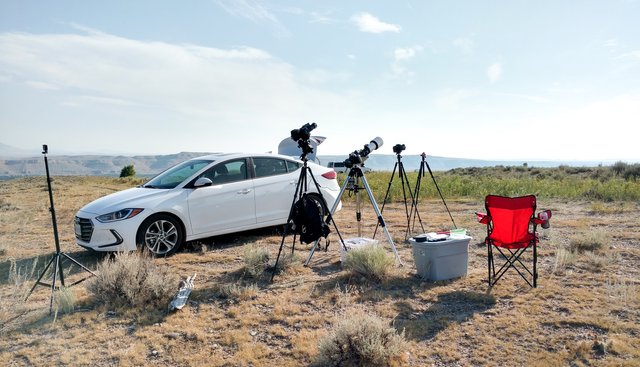
Getting set up. Yes that is a Monster Energy Drink in the cupholder of the chair.
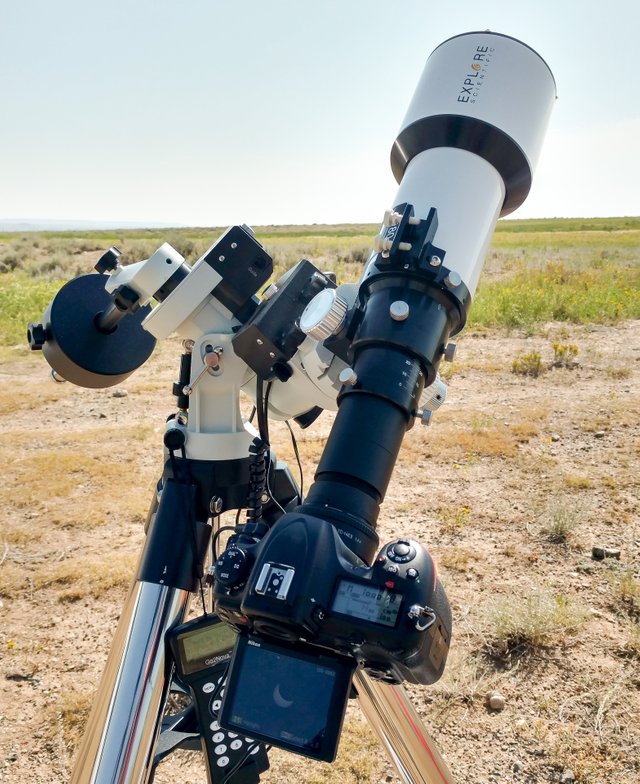
Nikon D500 attached to ES 80 refractor on CEM25P mount
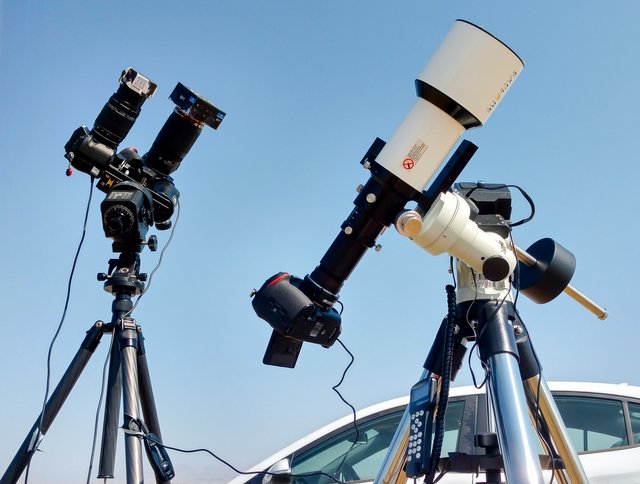
I put both tripods close together so I could quickly remove all the solar filters at the crucial moment
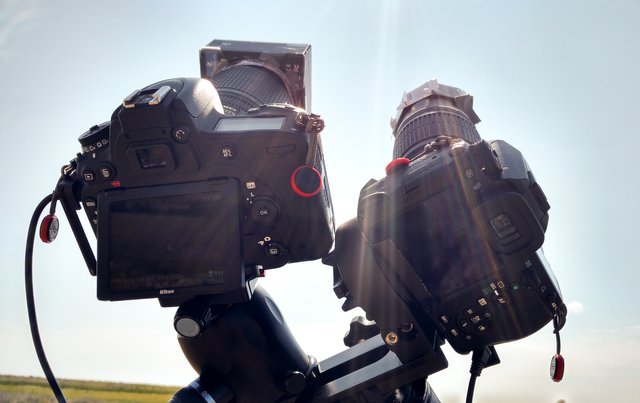
Nikon D750 + 70-300mm (left), Pentax K-5 + 55-300mm (right)
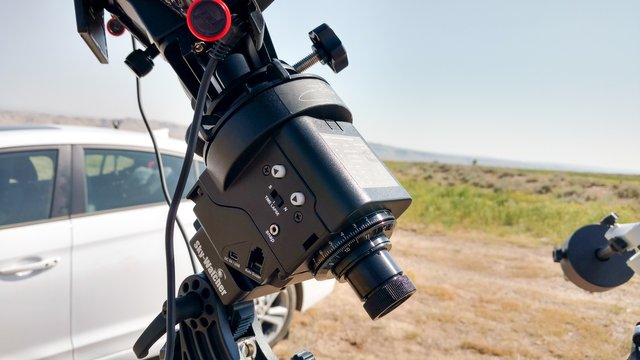
The Star Adventurer had no issues being loaded with two well-balanced cameras
First contact!
All the cameras were clicking at 10:18am local time when the moon first nipped into the sun. After a couple of minutes of interest, checking the cameras and observing with eclipse glasses I let the cameras run and got mentally prepared for the ISS transit at 10:43.
I'd put a lot of time, effort and money into research, preparation and self-transportation to this one spot in Wyoming for this one event that would last approximately 0.7 seconds. Don't mess it up now.
All I had to do was make sure the focus was perfect and turn the video on at the right time.
10:37...7 minutes to go! Time to focus...
10:41... Still trying to focus...I can't tell if it's sharp or not and now I'm panicking! So I make it as good as I can, stop fiddling and at 10:42:37 I start the video...
But the wind has picked up! Wind is my enemy at such long focal lengths, where the tiniest movement will shake the sun around in the frame. I grab the umbrella that I carried from Ontario for this purpose, mentally congratulating myself for being so forward thinking and try to shelter the telescope without covering it or bumping anything as I watch the video recording on the LCD screen. The sun was shaking a little but it calmed down just before...
10:43:54.54am on August 21st, 2017....I SAW IT! Like a fly flitting across a light bulb, there went the ISS, at a speed of more than 17,000mph, 250 miles above the surface of the earth, with six astronauts (three Americans, two Russians and an Italian) on board. Wow.
I quickly stopped the video to save it.
I had photographed the International Space Station from more than 250 miles away with a telescope and the Nikon D500, shooting 4K video at 30 frames per second. The ISS appeared in 21 of those frames. Exactly 0.7 seconds.
This had to have been the coolest thing I'd ever done.
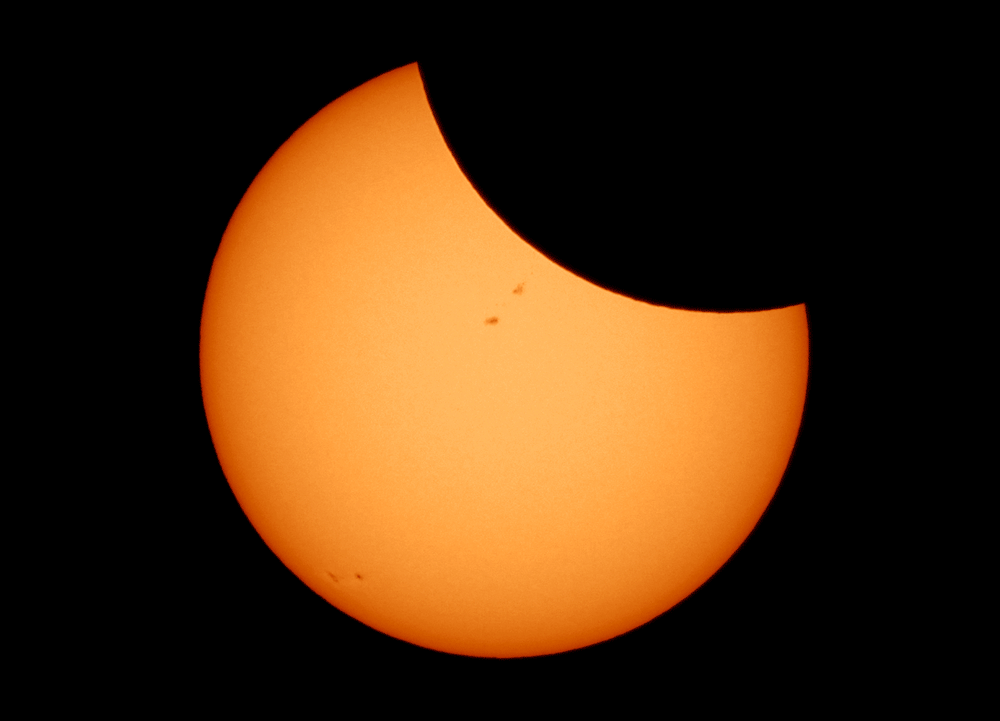
Looped animation of the ISS - you can see the telescope shaking from the wind
Totality awesome, dude!
I had achieved goal #1, but there was no time to party. The real magic was still to come, and capturing it would be more technically challenging.
Totality. How to explain totality? You can't, really, you have to experience it. As the sun is gradually covered by the moon the sky darkens almost imperceptibly - the light turns an odd grey and the temperature drops a little... but it's at the moment that the sun is finally and absolutely, 100% covered that things get crazy, and fast. It's DARK. Birds stop singing and the crickets waste no time before jumping into their night music. The temperature has dropped so much that you shiver. These things happen rapidly - much quicker than during a sunset, and about two minutes later the effects reverse.
We take the sun for granted, and its movement is so predictable that we use it to tell time and count the days. Thus, when the sun is unexpected blotted out in the middle of the day, it's weird. I'm shivering writing this. You hear stories about explorers and prophets using advance knowledge of eclipses to awe the masses...well, I understand that now.
As amazing as watching an eclipse is, I would never be happy with myself if I didn't document it - I'm not wired that way - I was always going to ignore those warnings about trying to take photos the first time. Just sit back and watch it? No way! Of all the things I've ever had to take a photo of, this was the most exciting!
Thankfully the months of research into camera settings, all the long talks with @brandongarrett and other friends about the minutiae of shutter speeds and ISO, intervals and custom menu settings paid off, because while I didn't do everything perfectly, I didn't totally fail, and that in itself was an accomplishment.
Photographing Totality
Different "effects" are seen in the moments leading up to totality, when the sunlight wraps around the edge of the moon and interacts with the moon's cratered surface:
- The Diamond Ring
- Bailey's Beads
- Prominences
- The Chromosphere
...and at mid-totality you can photograph:
- The Corona
- Earthshine - light reflected off the earth and back at the moon (the camera can pick this up with a long exposure)
...then it all repeats in reverse, so you get two cracks at capturing all the things.
I won't go into detail about my settings here - even if I remembered half of it, this is not meant to be a tutorial. Suffice to say I had three cameras focused on the sun (and moon!), each with their own settings for intervaled, bracketed exposures, and I had to take the filters off all of them at the precise time and then switch settings on a couple of them immediately after, then reverse the procedure two minutes later. Some people use a laptop and software like BackyardNikon or Eclipse Orchestrator to "schedule" exposures in advance and trigger the camera automatically at precise moments while they sit in a lawn chair and enjoy the show. I ran out of time to practice and perfect usage of this software, so instead I activated the interval timers on the Nikons in concert with auto-bracketing - a semi-automatic approach. It worked well enough but required a couple of hands-on moments.
I almost Cried
I was busy at the moment totality began, but once the cameras were chirruping merrily away I took a moment to look through the unfiltered binoculars - you're allowed during totality - and gazed at the sun, or rather not the sun but the moon, backlit by an ethereal gaseous solar emission called the corona, which is invisible to us at all other times. WOW. I was staggered. I almost cried. I've never seen anything so beautiful, and I can't even explain why. You had to be there. It was with difficulty I suppressed a shout - other observers within earshot were whooping it up.
Those two minutes and twenty-two seconds flew by and the event of the decade ended as abruptly as it began. The sun peeked around the other side of the man in the moon and all was relatively bright again. I put the solar filters back on the cameras, a little late, checked that everything was still working, and pushed thoughts of "well, now what do I do with the rest of my life?" away.
For those who have seen a partial eclipse and think they've seen it all: I hate to disappoint you, but a total eclipse is completely different. I'm not one to get effusive about this kind of stuff but it's almost magical. Let me put it this way: after totality was over I didn't even bother to watch the rest of the eclipse - I sat, a little stunned, in the car and edited photos instead. To those who couldn't see the show last year I don't say this to rub it in but rather to convince you to travel to the next available total eclipse. Don't miss it.
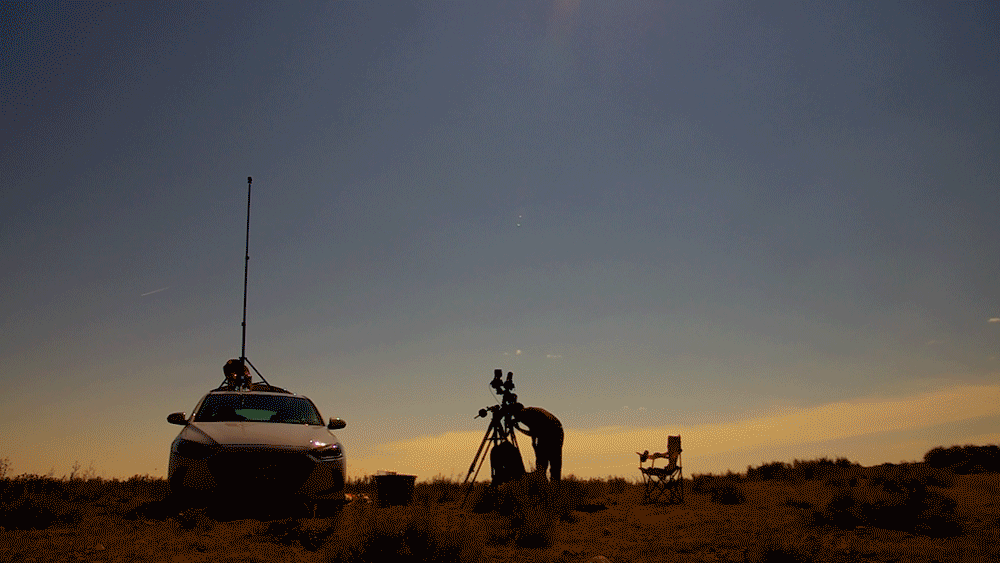
You can see how much the light changes in this sped-up animation
Eclipse Gallery
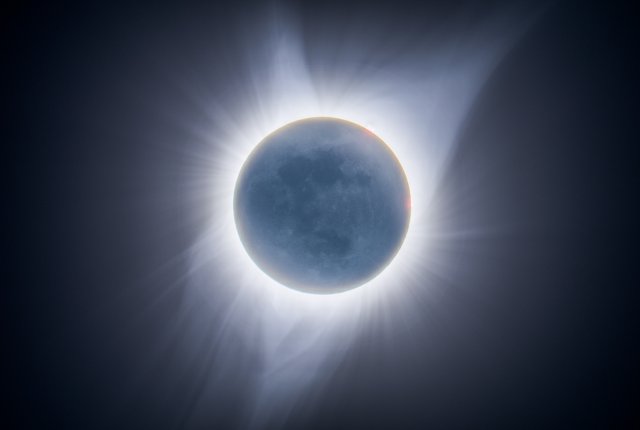
Earthshine and the corona (HDR composite).
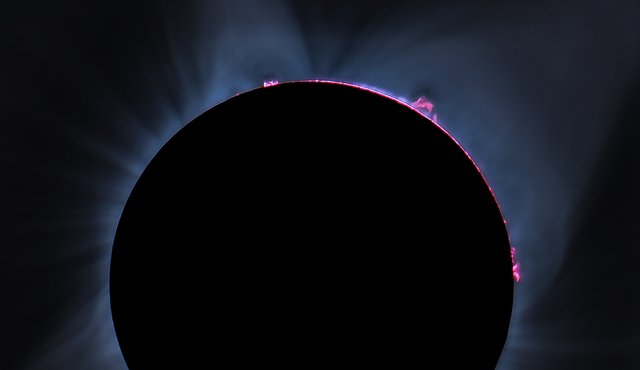
Closer view during beginning of totality to show prominences (flares from the solar surface) and the solar chromosphere (the red outline)
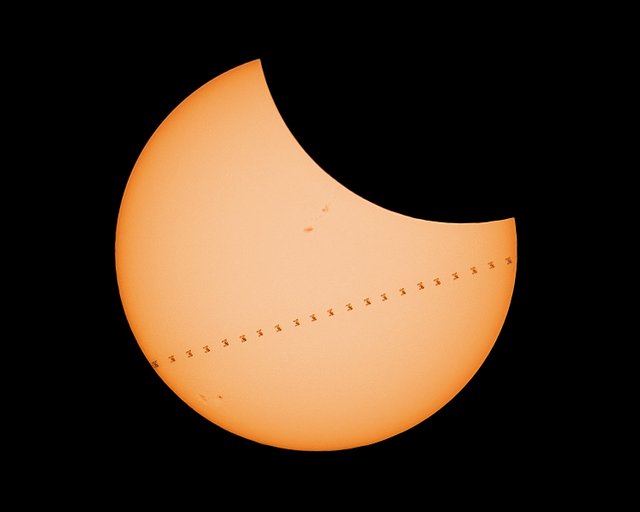
The ISS, with six humans aboard, passes in front of the sun. I combined and enhanced frames from the video into a single image to show the path.
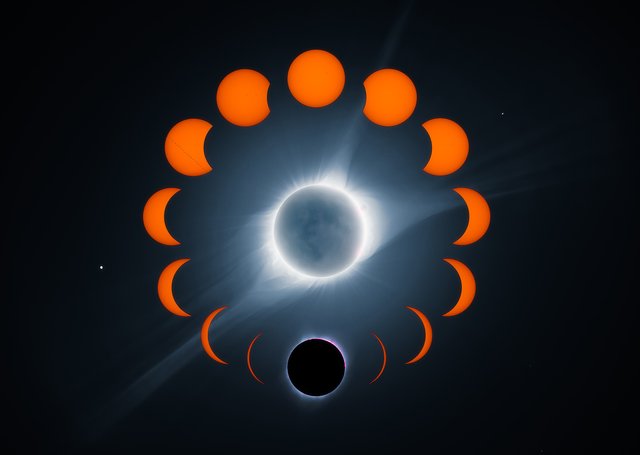
My "arrangement", showing the various stages of the eclipse. You can see how far the corona extends - and there are a couple of stars (Regulus is the one on the left)
What I did with the rest of my life
When the eclipse finished at 1pm I packed up and left, looking for the nearest internet (not an easy task). I pulled into the Crowheart gas station, where they told me that some guys had just been by after photographing the ISS Transit and were on their way to find internet to upload it. So I wasn't the only one!
This was never a race, but I thought I had something unique among a sea of pictures from the most-photographed event in American history, and I wanted to share it before it was old news.
A guy on a bicycle stopped by the gas station, introduced himself as Chris and looked at my photo (I was sitting outside editing on my laptop). He said I had something that the major networks might be interested in and that I should call them, immediately. It had already been a crazy day, so the idea of calling up CNN about my photo didn't sound so strange, and I appreciated his encouragement. Chris was riding his bike around the country, interviewing people and listening to their stories, which I think is a wonderful initiative: http://www.conversationswithus.com
Unfortunately nothing worked out with the major networks in the U.S. - it turns out that NASA had the same idea and had scooped me (haha, what a thing to say!). Their photographer Joel Kowsky was in another part of Wyoming outside the band of totality and presumably had internet access; they uploaded a photo of the transit shortly after it happened:
https://www.nasa.gov/image-feature/iss-transit-during-2017-solar-eclipse
My family got involved and helped me to contact news agencies in Canada. Elise Von Scheel wrote an article about my experience for CBC News Ottawa, which lead to an interview by Mark Sutcliffe on Ottawa Today - an extra-cool moment for me, having listened to Mark on the radio for years.
http://www.cbc.ca/news/canada/ottawa/ottawa-photo-wyoming-2017-eclipse-space-station-1.4257779
http://www.1310news.com/2017/08/23/derek-king-aug-23/
But I wasn't prepared for the next discovery...
Getting Smarter Every Day
The next day I was staying at the family-owned Paintbrush Motel in Riverton, Wyoming, and I've never been to a nicer motel. The owners and the staff were all so friendly and interested in my photos and excited for me to be in the news and doing radio interviews (if you're ever in the area, please stop there and tell them I sent you! http://www.paintbrushmotel.com)
While in the motel room, by some chance or fluke I happened to check Youtube, and I saw this in my feed, and I could not believe my eyes:
Destin Sandlin, from Youtube channel Smarter Every Day, along with photographer Trevor Mahlmann (tmahlmann.com) and Youtuber Matt Whitman (The Ten Minute Bible Hour) had been in the exact same area as me (within two miles) with the exact same purpose. Their experience mirrored my own.
Not only is Smarter Every Day one of my favourite Youtube channels, but it was a video from Destin back in June, where he talks to Dr. Gordon Telepun about his timer app¹ and the weird and wacky effects of totality, that had re-solidified my desire to photograph this eclipse (link: HOW TO WATCH THE ECLIPSE). It's fair to say that if it wasn't for this video I wouldn't have ended up in Wyoming on August 21st. The fact that Destin himself had come all the way to Crowheart, Wyoming to capture the International Space Station blew my mind, because the ISS transit had never been mentioned online - we arrived at that idea independently.
I wish I'd had the fortune to meet them while they were in Wyoming, but a friend (thank you, Kyle Van Etten!) helped me get in touch with Destin and Trevor and I was able to compare notes and chat with them later. This unforeseen coincidence of purpose ended up being a major highlight of my Eclipse Adventure.
¹ Dr. Gordon's Solar Eclipse Timer is an invaluable tool for observing or photographing an eclipse, because it gives audible cues - you can listen to it count down while you keep your eyes on other things
What did I learn from this experience?
- Total Solar Eclipses are just about the best thing ever.
- Astrophotography is expensive!
- I've discovered so much about the solar system - it's fun to learn things naturally (accidentally?) while researching related ideas.
- If you feel you have a worthwhile idea, go full steam ahead. I had many excuses to forego this opportunity, and nearly gave up a few times, but I know I'd never forgive myself if I'd missed the eclipse, or even if I'd just given up on the ISS and then saw the Smarter Every Day video
Final Thoughts
I hope you enjoyed my story and the photos. I know this was a long read, but it was important for me to record this experience while the memory was fresh. If you take away one thing, let it be this: if you ever have the opportunity to see a total solar eclipse, take advantage of it. Whether you photograph it or view it, on your own or with friends and family, I believe it's worth doing at least once in a lifetime. Oh, and bring good binoculars so you can see it up close with your own eyes!
In the meantime, lets look at more photos and get inspired! My friends have been posting their pictures from the Great American Solar Eclipse on Steemit, and I'd love for you go to check out their work. I was sad not to be able to hang out with them during this event, but we had to make separate plans:
@brandongarrett (who got a better picture of Bailey's Beads): https://steemit.com/photofeed/@brandongarrett/great-american-eclipse-of-2017
@caseygrimley (who photographed the eclipse with a beautiful landscape): https://steemit.com/photofeed/@caseygrimley/2017-solar-eclipse-adventure
@jarvie (who multi-tasked and photographed both a landscape and a closeup) https://steemit.com/photofeed/@jarvie/eclipse-in-the-sawtooth-mountains-homage-to-derekkind-epic-post
P.S. there's a blue supermoon lunar eclipse in the early hours of Jan 31st...
Some parts of the world will be able to see a total lunar eclipse. NASA has the details:
https://www.nasa.gov/feature/super-blue-blood-moon-coming-jan-31
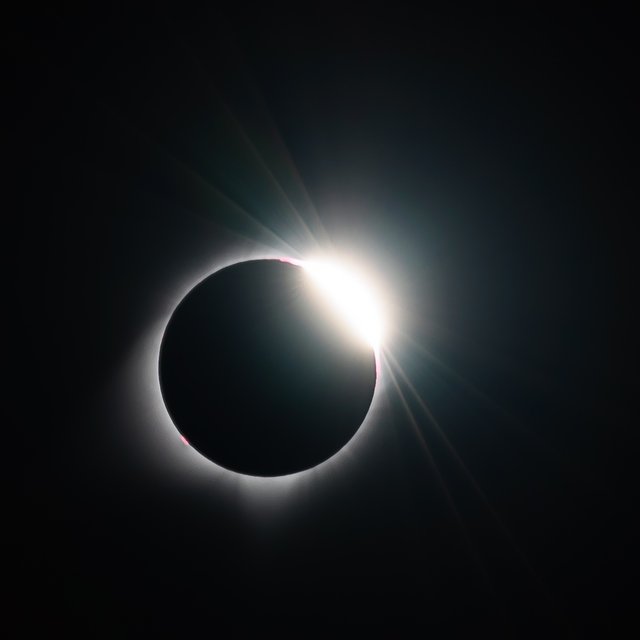
I have just read it again; it has to be the best eclipse post I have seen. Your a legend mate.
@intrepidphotos aww, thank you!!!
This post still hasn't gotten the attention it deserves. I hope this changes
Hey thanks! I appreciate the support. Even if it doesn't catch on right away I'm glad to have written it and shared it here first. :)
That compilation shot is EPIC ... I've not seen one done in a circle!!
Thank you!! The circle isn't my idea, but these things are usually made on a black background, so I wanted to give it a different feel (even if it makes the moon look like it's wearing an invisibility cloak).
P.S. that animation is also super cool!
Thanks! Gotta love how internet speeds are going up and making higher quality animated GIFs consumable. I have to do more of that!
I really enjoyed this article. The looped animation of the ISS crossing the sun with the arc of the moon is the coolest thing to watch. It was hard to stop watching it and continue on with the rest of your story; but it is well worth the time. Thank you for sharing
Hehe, I got trapped watching that gif for a little while myself. I appreciate you actually reading my story and taking the time to comment! :D
WOW WOW WOW! Amazing images, explanation and really high tech equipment. For how long have you been doing this? Congrats buddy :)
Thank you, @epajezz! I've been taking photography seriously since around 2012. :)
You're ridiculous. Those are flat out amazing. That's all I can say.
Hehe, thanks man! :D
So awesome. The effort and planning to get even an ordinary photo of this event is huge and you've come away with stunning images. Well done!
Thanks, Kieran! It's true, but I figured if I'm going to go to all that effort just to take an ordinary photo, might as well go a tiny bit farther and try to be unique. :)
Oh my goodness. I have to say, that first image is honestly one of my favorite images of all time. FANTASTIC work! You certainly put in the time and effort, and I have no doubt it payed off. Also, Smarter Every Day is one of my favorite YouTube channels.
It's a great channel, eh? I could watch that all day. Thank you, I'm glad you like that first image - I put it together last night and I'm really pleased with how it turned out. :)
Very educational! That's too bad you didn't run into him. You're making me regret staying in Alaska during the eclipse! I hope I can witness the full thing one day.
It's sweeping across North American again in 2024, if you want to head towards the eastern part of the continent. :)
One of the best posts ever. I love astronomy and was top of my class at university in astronomy, but never went further. I really love the photo of the image of the ISS crossing in front of the sun.
Well done! Amazing job.
Wow, thank you Steve, and thanks for resteeming! Astronomy is fascinating but I'm no expert on the science, just happy to capture some of the beauty of an event like this. Glad you liked the post! :)
Dude, such an incredible post. The shots you were able to get are absolutely awe-inspiring. Hope you are proud!
Thank you so much!!! I'm really happy, and honestly just relieved that it worked out! A bit of bad luck and it could all have been different. :)